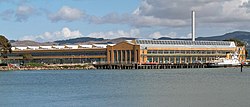Ford Richmond Plant
|
Ford Motor Company Assembly Plant
|
|
 |
|
| Location | Richmond, California |
|---|---|
| Coordinates | 37°54′38.6″N 122°21′30.1″W / 37.910722°N 122.358361°WCoordinates: 37°54′38.6″N 122°21′30.1″W / 37.910722°N 122.358361°W |
| Built | 1930 |
| Architect | Albert Kahn |
| NRHP Reference # | 88000919 |
| Added to NRHP | June 23, 1988 |
The Ford Richmond Plant, formally the Ford Motor Company Assembly Plant, in Richmond, California, was the largest assembly plant to be built on the West Coast and its conversion to wartime production during World War II aided the United States' war effort. The plant is part of the Rosie the Riveter/World War II Home Front National Historical Park and is listed on the National Register of Historic Places. It currently houses the National Park Service visitor center, several private businesses and the Craneway Pavilion, an event venue.
Built in 1930 during the Great Depression, the assembly plant measures nearly 500,000 square feet (46,450 m²). The factory was a major stimulant to the local and regional economy and was an important development in Richmond's inner harbor and port plan. Ford became Richmond's third largest employer, behind Standard Oil and the Santa Fe Railroad. It is also an outstanding example of 20th-century industrial architecture designed by architect Albert Kahn, known for his "daylight factory" design, which employed extensive window openings that became his trademark. The main building is composed of a two-story section, a single-story section, a craneway, a boiler house and a shed canopy structure over the railroad track.
To ensure that America prepared for total war by mobilizing all the industrial might of the United States, President Franklin D. Roosevelt banned the production of civilian automobiles during World War II. The Richmond Ford Assembly Plant switched to assembling jeeps and to putting the finishing touches on tanks, half-tracked armored personnel carriers, armored cars and other military vehicles destined for the Pacific Theater. By July 1942, military combat vehicles began flowing into the Richmond Ford plant to get final processing before being transported out the deep-water channel to the war zones. The "Richmond Tank Depot" (only one of three tank depots in the country) as the Ford plant was then called, helped keep American fighting men supplied with up-to-the-minute improvements in their battle equipment. Approximately 49,000 jeeps were assembled and 91,000 other military vehicles were processed here.
...
Wikipedia



